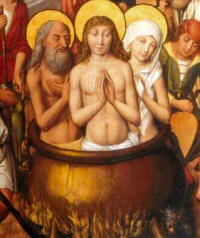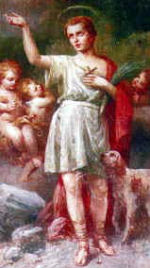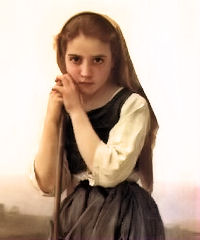
Daily Readings for: June 15, 2013
(Readings on USCCB website)
Collect: O God, from whom all good things come, grant that we, who call on you in our need, may at your prompting discern what is right, and by your guidance do it. Through our Lord Jesus Christ, your Son, who lives and reigns with you in the unity of the Holy Spirit, one God, for ever and ever.
Ordinary Time: June 15th
Saturday of the Tenth Week of Ordinary Time
Old Calendar: Saints Vitus, Modestus, and Crescentia, martyrs; St. Germaine Cousin (Hist)
According to the 1962 Missal of Bl. John XXIII the Extraordinary Form of the Roman Rite, today is the feast of Sts. Vitus, Modestus and Crescentia. Very little is known of these saints. St. Vitus was martyred in Lucania in South Italy. He is invoked for the cure of epilepsy (St. Vitus' dance).
Historically today is the feast of St. Germain Cousin who was born in Pibrac, France. She was abused as a child and spent her short life as a shepherdess.
Sts. Vitus, Modestus, and Crescentia The relics of St. Vitus (also known as St. Guy) were transferred to various places -- an arm is in St. Vitus Cathedral, Prague. According to legendary Acts, the boy Vitus was baptized without the knowledge of his father. Having found out about it, his father had him beaten with rods by the magistrate. While his parent was considering more cruel punishments, Vitus, his teacher Modestus, and his nurse Crescentia fled to Sicily upon the command of an angel. But there, too, they were persecuted because of the faith. When thrown into a cauldron of burning oil, they, like the three youths, sang hymns of praise. And wild beasts would not harm them. It is related that they were then quartered. Vitus is one of the "Fourteen Holy Helpers" (he is invoked against epilepsy and St. Vitus' dance).
The relics of St. Vitus (also known as St. Guy) were transferred to various places -- an arm is in St. Vitus Cathedral, Prague. According to legendary Acts, the boy Vitus was baptized without the knowledge of his father. Having found out about it, his father had him beaten with rods by the magistrate. While his parent was considering more cruel punishments, Vitus, his teacher Modestus, and his nurse Crescentia fled to Sicily upon the command of an angel. But there, too, they were persecuted because of the faith. When thrown into a cauldron of burning oil, they, like the three youths, sang hymns of praise. And wild beasts would not harm them. It is related that they were then quartered. Vitus is one of the "Fourteen Holy Helpers" (he is invoked against epilepsy and St. Vitus' dance).
Excerpted from The Church's Year of Grace, Pius Parsch
Patron: Vitus: actors; against animal attacks; against dog bites; against lightning; against oversleeping; against storms; against wild beasts; comedians; Czechoslovakia; dancers; dog bites; dogs; epilepsy; Forio, Italy; lightning; oversleeping; Prague, Czech Republic; rheumatic chorea; Saint Vitus Dance; snake bites; storms.
Symbols: Vitus: Wolf or lion; cockatrice on a book; fire; cock; chained dog; cauldron of boiling oil; palm and cauldron; palm and dog; chalice and dog; sword and dog; sword and rooster;
Often Portrayed as: Boy with a rooster and a cauldron; With Modestus and Crescentia as they refuse to worship idols; being put into an oven; young prince with a palm and sceptre.
Crescentia: Boat piloted by an angel; cauldron of oil; sword.
St. Germaine Cousin Saint Germaine Cousin was born in 1579 in Pibrac, a small village not far from Toulouse, France. From her earliest years she was a frail, sickly child, and throughout her life was afflicted with scrofula, a tubercular condition affecting particularly the glands of the neck. In addition, her right arm and hand were deformed and partially paralyzed. In spite of her many afflictions, the emaciated child possessed a charming, sweet disposition. Germaine endured not only bodily sufferings, but harsh, cruel treatment from her stepmother, who had a deep aversion for the little girl. The child was almost starved to death and obliged to sleep in the barn on a pile of leaves and twigs under the stairway. At break of day, summer and winter, she would drive the sheep into the fields to graze, then watch them until evening. She had to spin during this time, and if the allotted wool was not spun, she was severely punished.
Saint Germaine Cousin was born in 1579 in Pibrac, a small village not far from Toulouse, France. From her earliest years she was a frail, sickly child, and throughout her life was afflicted with scrofula, a tubercular condition affecting particularly the glands of the neck. In addition, her right arm and hand were deformed and partially paralyzed. In spite of her many afflictions, the emaciated child possessed a charming, sweet disposition. Germaine endured not only bodily sufferings, but harsh, cruel treatment from her stepmother, who had a deep aversion for the little girl. The child was almost starved to death and obliged to sleep in the barn on a pile of leaves and twigs under the stairway. At break of day, summer and winter, she would drive the sheep into the fields to graze, then watch them until evening. She had to spin during this time, and if the allotted wool was not spun, she was severely punished.
The village children, not sharing the hostility of the adults toward this forlorn child, loved to listen to her speak about the goodness and love of God while she guarded her flock. The only instruction Germaine ever received was the catechism taught after Sunday Mass in the village church, which she attended with joy. During the long hours of solitude she spent in the fields and in the stable at night, she remained in sweet communion with God, and never complained of her hard life.
Every morning she was at Mass, and afterwards went to kneel before Our Lady’s shrine. To reach the church she had to cross what was ordinarily a small stream; but after a heavy rain it would become a raging torrent. Several times at those moments, the villagers were amazed to see the rushing waters separate when Germaine approached, and then to watch her cross on dry land. When she left her sheep to go to church, she would place her staff upright in the ground, and the sheep never went far from it. One day the stepmother was seen pursuing Germaine as she drove the sheep down the road. She was accusing the girl of having stolen some bread and concealing it in her apron. When Germaine unfolded her apron, fragrant flowers, foreign to that region, fell to the ground.
Germaine died one night in the year 1601, at the age of twenty-one, and was buried as was the custom in those days, in the village church. Forty-three years later, when a relative was to be buried near her and the stones were removed, the grave-digger found to his amazement, the body of a beautiful young girl in a state of perfect preservation. His pick had struck her nose, and the wound was bleeding. Some of the older residents identified the girl as Germaine Cousin. Miracle after miracle occurred, and in 1867 the neglected little waif of Pibrac was inscribed in the list of Saints by Pope Pius IX. Annually thousands of pilgrims visit the church of Pibrac, where the relics of Saint Germaine are enshrined.
Excerpted from Heavenly Friends: a Saint for each Day, by Rosalie Marie Levy
Patron: Victims of; abuse and child abuse, of abandoned people, people with disabilities, against poverty, illness and loss of parents. She is also the patron of girls from rural areas.
Symbols:With a shepherd's crook or with a distaff; with a watchdog, or a sheep; or with flowers in her apron.
Things to Do:Read more about the life of St. Germaine Cousin here.